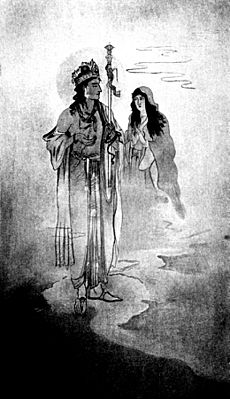Nandalal Bose facts for kids
Quick facts for kids
Nandalal Bose
|
|
|---|---|
 |
|
| Born | 3 December 1882 |
| Died | 16 April 1966 (aged 83) |
| Nationality | Indian |
| Known for | Painting |
| Movement | Contextual Modernism |
| Awards | Padma Vibhushan (1954) |

Nandalal Bose (born December 3, 1882 – died April 16, 1966) was a very important artist in modern Indian art. He helped shape a unique style of art in India. He was a key figure in a movement called Contextual Modernism.
Nandalal Bose learned from Abanindranath Tagore, another famous artist. Bose became known for his special "Indian style" of painting. In 1922, he became the head of Kala Bhavan, an art school in Santiniketan. He was inspired by the Tagore family and the ancient murals. His famous paintings often showed scenes from Indian stories, women, and village life.
Many art experts today think his paintings are among India's most important modern artworks. In 1976, the Indian government recognized his work. They declared his art as "art treasures" because of their great artistic value. He also helped illustrate the Constitution of India.
Contents
Early Life and Art Journey
Nandalal Bose was born on December 3, 1882. He grew up in a middle-class family in Haveli Kharagpur, Bihar. His family originally came from Jejur, West Bengal. His father, Purna Chandra Bose, worked in the Darbhanga Estate. His mother, Khetramoni Devi, was a talented homemaker. She often made toys and dolls for young Nandalal.
From a young age, Nandalal loved creating things. He enjoyed making models and decorating special festival areas.
In 1898, when he was fifteen, Nandalal moved to Calcutta. He went to the Central Collegiate School for his high school studies. After finishing school in 1902, he continued his college education there. In June 1903, he married Sudhiradevi, a family friend's daughter.
Nandalal really wanted to study art. However, his family did not allow it at first. He struggled in his regular college classes. He even tried studying commerce at Presidency College in 1905. After failing many times, he finally convinced his family. They agreed to let him study art at Calcutta's School of Art.
A Career in Art and Influence
As a young artist, Nandalal Bose was greatly inspired. He studied the ancient murals found in the Ajanta Caves. He joined a group of artists and writers from around the world. This group wanted to bring back classical Indian culture. Famous people like Okakura Kakuzō and Abanindranath Tagore were part of this circle.
In 1930, Mahatma Gandhi was arrested. This happened for protesting a British tax on salt. To mark this event, Bose created a special print. It showed Gandhi walking with a staff. This image became a symbol for the non-violence movement.
His unique artistic talent was noticed by many. Famous artists and critics like Gaganendranath Tagore admired his work. These art lovers believed that honest criticism was important for art to grow. So, they started the Indian Society of Oriental Art.
In 1922, he became the principal of Kala Bhavana. This is the College of Arts at Tagore's International University, Santiniketan.
Jawaharlal Nehru, India's first Prime Minister, asked him for a special task. Nandalal Bose was asked to design the emblems for India's national awards. These included the Bharat Ratna and the Padma Shri. He also worked with his student, Beohar Rammanohar Sinha. Together, they decorated the original copy of the Constitution of India.
Nandalal Bose passed away on April 16, 1966, in Calcutta.
Today, the National Gallery of Modern Art in Delhi has many of his artworks. They have about 7000 pieces in their collection. This includes his 1930 print of the Salt March. It shows Mahatma Gandhi during the famous Dandi March. The gallery also has seven posters he made for the 1938 Indian National Congress meeting.
Nandalal Bose's Importance in Indian Art
Nandalal Bose holds a very special place in the history of modern Indian art. He was like a great organizer of ideas. He took different thoughts from many important people. These included Abanindranath Tagore, Rabindranath Tagore, and Mahatma Gandhi. He combined these ideas into a new plan for Indian art.
He had a deep passion for art. He also had a very sharp mind. This helped him understand different art traditions. He made these traditions easy for new Indian artists to learn from. He did all this quietly, without seeking much attention. Because of this, the full importance of his work is still being understood.
Notable Students of Nandalal Bose
Nandalal Bose taught many talented students. Some of his well-known students include:
- Benode Behari Mukherjee
- Ramkinkar Baij
- Beohar Rammanohar Sinha
- K. G. Subramanyan
- A. Ramachandran
- Satyajit Ray (the famous filmmaker)
- Dinkar Kaushik
- Amritlal Vegad
A.D. Jayathilake from Ceylon (now Sri Lanka) was also one of his students. He studied under Dr. Nandalal Bose from 1948 to 1952. Two unique paintings by Dr. Nandalal Bose, "Arjuna Tree" and "Mango trees," are now with A.D. Jayathilake.
Honours and Awards Received
Nandalal Bose left a huge mark on Indian art. He was the first person to receive a scholarship from the Indian Society of Oriental Art. This society was founded in 1907.
In 1956, he became the second artist ever to be chosen as a Fellow of the Lalit Kala Akademi. This is India's National Academy of Art. In 1954, Nandalal Bose received the Padma Vibhushan. This is one of India's highest civilian awards.
The University of Calcutta gave him an honorary D.Litt. degree in 1957. Vishvabharati University also honored him with the title 'Deshikottama'.
The Academy of Fine Arts in Calcutta awarded Nandalal the Silver Jubilee Medal. In 1965, the Asiatic Society of Bengal gave him the Tagore Birth Centenary Medal.
A documentary film about the artist was made in 1984. It was called Acharya Nandalal and directed by Harisadhan Dasgupta.

